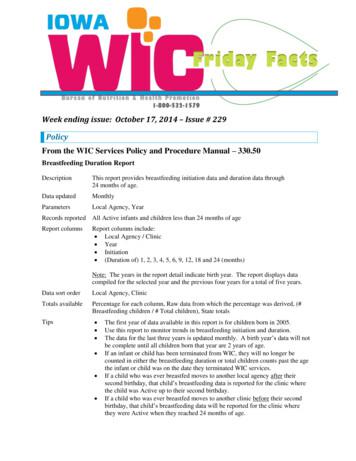Iowa’s Teacher Leadership & Compensation System
Iowa’s TeacherLeadership &CompensationSystemIowa Teacher & PrincipalLeadership SymposiumAugust 4, 2014
Teacher Leadership & Compensation SystemDivision VII of HF 215 created the Teacher Leadership and CompensationSystem, as well as the Teacher Leadership Supplement (TLS) categorical fundingstream. Goals: attract and retain effective teacherspromote collaborationreward professional growth and effective teachingimprove student achievement by strengthening instruction Planning Grants: 3.5 million available in 2013 Phased-in Entry: 50 million available per year for the 2014-15,2015-16, and 2016-17 school years
Teacher Leadership & Compensation System (cont.)Division VII of HF 215 provides school districts three models to consider in developing alocal teacher leadership and compensation plan.Teacher CareerPaths Model(284.15)InstructionalCoach Model(284.16)Based on the workof Iowa’s TeacherLeadership andCompensation TaskForce and createsmodel, mentor, andlead teacher roles.Includes threeleadership roles:model teacher,instructional coach,and curriculum andprofessionaldevelopment leaderComparable Plan Model (284.17)Includes minimum criteria all plansmust meet: (1) minimum salary of 33,500 for all full-time teachers; (2)increased support for new teachers;(3) differentiated, multiple teacherleadership roles; (4) rigorous selectionprocess; (5) aligned professionaldevelopment system.
Participating DistrictsThe Commission approved applications from 39districts, representing 1/3 of Iowa’s students.
Creating a System of SupportThe Department of Education is working with stakeholders across Iowa to identify, coordinateand provide opportunities for teacher leaders and school leaders to build the knowledge andskills they need to be successful in these new leadership roles.FocusAreasAdult Learning CollaborativeCultureCommunicationContent,Pedagogy &AssessmentDesign anddelivery ofprofessionallearning.Cultivation of skillsassociated witheffective dialoguewith colleagues.Implementationof research andbest practice incontent (IowaCore),instruction andassessment.Facilitation ofgroup processesand developmentof necessarystructures forprofessionallearningenvironments tobe hipIntegration andalignment ofdistrict tion ofdata analysisand datainformeddecisionmaking.Facilitation andenactment of avision for schoolimprovementwith teacherleadership as apoint of leverage.
Creating a System of Support (cont.)Phase 1 Identify/revisit the needs of the system (students,teachers, teacher leaders, administrators, communitystakeholders) Establish and communicate a vision for teacherleadership in the greater context of schoolimprovement (ground the work in a strategic plan, theIPDM, MTSS, or some other improvement model) Determine/revisit the goals for a system of teacherleadership and identify indicators of success (attend toimpact and effect) Understand and engage in learning about the changeprocess Create structures and schedules conducive tocollaboration and professional learningPhase 2 Engage in trainingo Coaching (teacherleaders of teachers,principals of teacherleaders,superintendents ofprincipals)o Content Knowledgeand Pedagogyo Adult learningo Systems thinking Cultivate collaboration Monitor progress viaanalysis of indicatorsPhase 3 Monitor andevaluate impactand effect
Managing the Change ProcessFor many school districts, developing a local teacher leadership plan will be anexercise in second-order change.First-Order ChangeSecond-Order Change Consistent with prevailingvalues and norms Not obvious how it willmake things better Meets with generalagreement Requires people to learnnew approaches, or Implemented using people’sexisting knowledge andskills It conflicts with prevailingvalues and normsFrom Waters, Marzano, and McNulty “First-Order versus SecondOrder Change”
Managing the Change ProcessPeople often resist change for powerful, compelling pleEffectsLoss of FaceResistanceto ChangeConcernsabout FutureCompetenceFrom Rosabeth Moss Kanter,“Resistance to Change”
Managing the Change ProcessChange can be difficult. Chip and Dan Heath provide a framework ensuring that thechange takes root.Providecrystal cleardirectionEngagepeople’semotionalsideShape thepathFrom Switch: How to Change When Change is Hard Chip Heathand Dan Heath
Lessons From the PanelJeff Dieken, Principal, Hudson High SchoolDeron Durflinger, Superintendent,Van Meter Community School DistrictRay Feuss, Teacher, Kenwood Elementary in the Cedar Rapids Community SchoolDistrictPaul Gausman, Superintendent, Sioux City Community School DistrictKelly Simon, Director of Curriculum and Instruction, Western Dubuque CommunitySchool DistrictBrenda Garcia-Van Auken, Parent and Iowa Board of Educational Examiners Member,MuscatinePaula Vincent, Chief Administrator, Heartland Area Education Agency
local teacher leadership and compensation plan. Teacher Career Paths Model (284.15) Instructional Coach Model (284.16) Comparable Plan Model (284.17) Based on the work of Iowa’s Teacher Leadership and Compensation Task Force and creates model, mentor, and lead teacher roles. Includes th
Iowa Chapter, American Academy of Pediatrics Iowa Dental Association Iowa Department of Public Health Iowa Health Care Association Iowa Hospital Association Iowa Medical Society Iowa Nurses Association Iowa Pharmacy Association Iowa Veterinary Medical Association Iowa‘s Statewide Epidemiology Education and Consultation Program State Hygienic .
Agricultural Biotechnology Stewardship Technical Committee (ABSTC), Iowa Corn Growers Association (ICGA), the Iowa Chapter of the American Society of Farm Managers and Rural Appraisers (ASFMRA), Iowa Farm Bureau Federation (IFBF), Iowa Independent Crop Consultants Association, Iowa Institute for Cooperatives (IIC), Iowa Soybean Association (ISA),
TABLE OF CONTENTS UNIT LESSON TITLE PAGE NO. I 1.1 Compensation 3 1.2 Compensation Responsibilities 17 1.3 Compensation System Design Issues 23 1.4 Compensation Philosophies 29 1.5 Compensation Approaches 34 II 2.1 Fringe Benefits 41 2.2 Strategic Compensation
Clinic compensation (Total Compensation -Academic Compensation) 170,000 Dr. Smith earned 5 points in 3 different categories in calendar year 2018. Dr. Smith has therefore met the expectations for 100% the benchmark. Dr. Smith's compensation in FY20 is 200,000 30,000 (Academic Compensation) 170,000 (Clinical Compensation)
AERLP Description Created by Iowa legislature in May 1996 1997 Iowa Code, Section 476.46 Amendment to the 1990 Iowa Energy Efficiency Act Funded via Iowa’s investor-owned utilities Competitive application process Eligibility All individuals and groups except Iowa’s gas and electric utilities that are not required to be rate regulated
c. Commitment to Iowa Trauma System and EMS activities, for example Iowa Trauma Coordinators, American College of Surgeons (ACS), Iowa Chapter Committee on Trauma, Iowa Chapter of American College of Emergency Physicians (ACEP), Iowa Emergency Medical Service Association (IEMSA),Trauma System Advisory Council (TSAC), System Evaluation Quality
Iowa Department of Public Health Text4baby Iowa State Contact 515-778-2212 Kelly.Schulte@idph.iowa.gov Let’s work together to promote this terrific resource to pregnant women and new mothers in Iowa! Approximately 1.8% of estimated pregnant women and new moms in Iowa have enrolled in Text4baby since its launch.
Araling Panlipunan Ikalawang Markahan - Modyul 5: Interaksiyon ng Demand at Supply Z est for P rogress Z eal of P artnership 9 Name of Learner: _ Grade & Section: _ Name of School: _ Alamin Ang pinakatiyak na layunin ng modyul na ito ay matutuhan mo bilang mag-aaral ang mahahalagang ideya o konsepto tungkol sa interaksiyon ng demand at supply. Mula sa mga inihandang gawain at .























